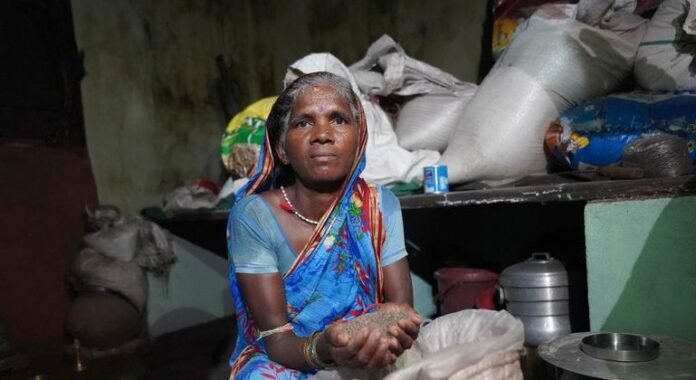More than a dozen women of various ages, dressed in beautifully tied, colorful saris, pose smilingly for photographs. They have won the war against starvation and uncertain weather.
These women hail from Saruda, Ganjam in the eastern Indian state of Odisha. Odisha is one of the Indian states most vulnerable to the effects of climate change.
Pointing to the torrential rain outside, 42-year-old Pavitra says, “We are living in very uncertain times. Either it rains a lot, or it doesn’t rain at all, or it doesn’t rain on time. “The soil is no longer fertile, and our bodies have been attacked by diseases due to long-term pesticide use.”
The monsoon sky seems to create an ever-changing canvas, amid which community members gather in green millet fields. Requiring very little water and not much fertilizer, these hardy plants thrive in extreme climates. These farms mark the comeback of millet – an ancient grain that is fast emerging as a superfood.
Today humanity is facing a huge challenge of food security or starvation crisis. Climate change is having a major impact on food production and food systems. The nutritional value of our food is declining due to reduced crop production and loss of biodiversity.
Rise of millets
“I remember that especially pregnant women and those who needed extra nutrition used to eat it, but when rice became a staple food, people stopped eating it as it was seen as food for the poor and was eaten only when no other food was available. .”
Millets can also grow in less fertile, saline or shallow soils, require minimal water and take only 60-90 days to grow. They are classified as C4 crops and are known to absorb excess carbon dioxide from the atmosphere. Due to this, it is also friendly to the environment. Millet can be stored for long periods under normal conditions, making it a “famine time store” for small farmers dependent on rain. In fact, it will not be wrong to say that millet is the crop of the future.
Millet is one of the oldest crops used by humans for food. Recently, steps have been taken to restore millet production, access and integration into the food system from farm to plate.
India is one of the largest millet producing countries in the world. In 2021, India submitted a resolution to the UN Secretary-General’s Council requesting that 2023 be declared as the International Year of Peace.

Health and nutrition
Pratima Pradhan, a resident of Lamungia village in Raika block, said, “I had to be admitted to the hospital because I was not feeling sick, I was anaemic, but it didn’t help, then I remembered that the doctor advised me to include millet in my diet.”
Pratima tried to find millet in the local market but was nowhere to be found. His village is known for growing vegetables and turmeric. Like other members of the community, he also cultivated only paddy along with these crops.
Then he took millet seeds from the state agriculture department staff and from here his journey to become a millet farmer began. In 2019, he grew a handful of seeds for his own use. The yield has been good. This attracted the attention of other farmers and they also started cultivating millet. For this he kept going to Pratima for advice.
Empowerment and tolerance
In addition to nutrition and health, women farmers have reaped economic benefits from millet cultivation. Organized into self-help groups, these women are active in the development and marketing of millet-based products. The women manage the processing and sale of millet, which is sold through ‘millets on wheels’ and tiffin canteens across the state.

Subasa Mahant of Singaporepur in the state is a living example of the change brought about by the shift towards millet cultivation. The villagers call her ‘Millet Ma’ because of her important role in the promotion of millets.
Proud of her success, she says, “Like Lakshmi, the goddess of wealth and prosperity, I started with 250 grams of seeds, three times more than rice, and farmers from far-flung villages come to me for advice.”
He is working on his farm. For additional income he has started poultry farming and is also making organic fertilizers. But his most prized possession is his tractor, which is parked at the entrance of the house.
cascading effect
In 2017, the Odisha Millets Mission (OMM) was launched to promote millet production and consumption in the state. Under this mission, millet production has increased from 3,333 hectares in 2017 to 53,230 hectares by 2022-2023.
OMM focuses on increasing domestic consumption of millet, establishing decentralized processing and other infrastructure, marketing millets through Farmers Producer Organizations (FPOs) and marketing millets through the Public Distribution System (PDS), Integrated Child Development Scheme (ICDS), and Madhya Pradesh. Contributed significantly to inclusion in the Food Scheme (MDMS).
World Food Program (WFP) and Odisha Millet Mission (OMM) are working together to improve food and nutrition security in Odisha. Under this partnership, the mission’s achievements include millet evaluation, integration of millet into the food system and promotion as a climate-resilient cereal for nutritional security.
Under this partnership, there are plans to help millets become a part of the diet again in Odisha and expand such initiatives to other regions and countries.

